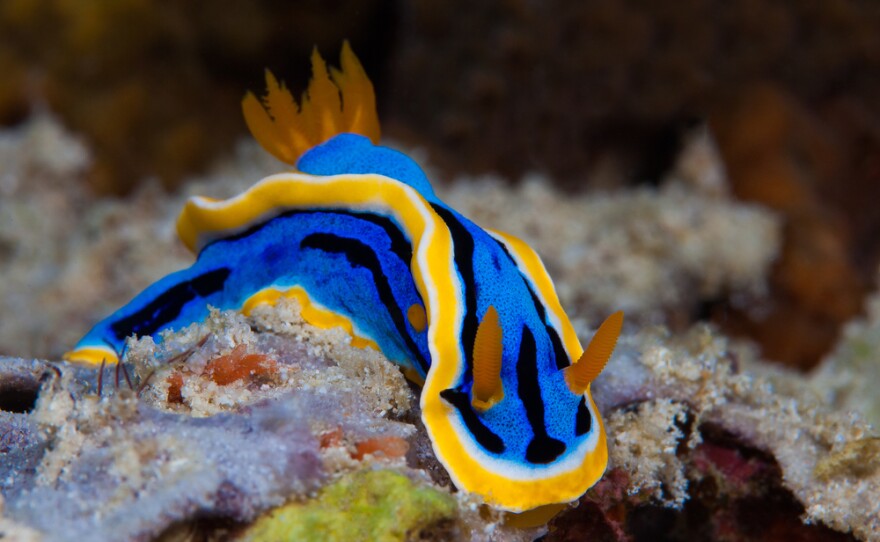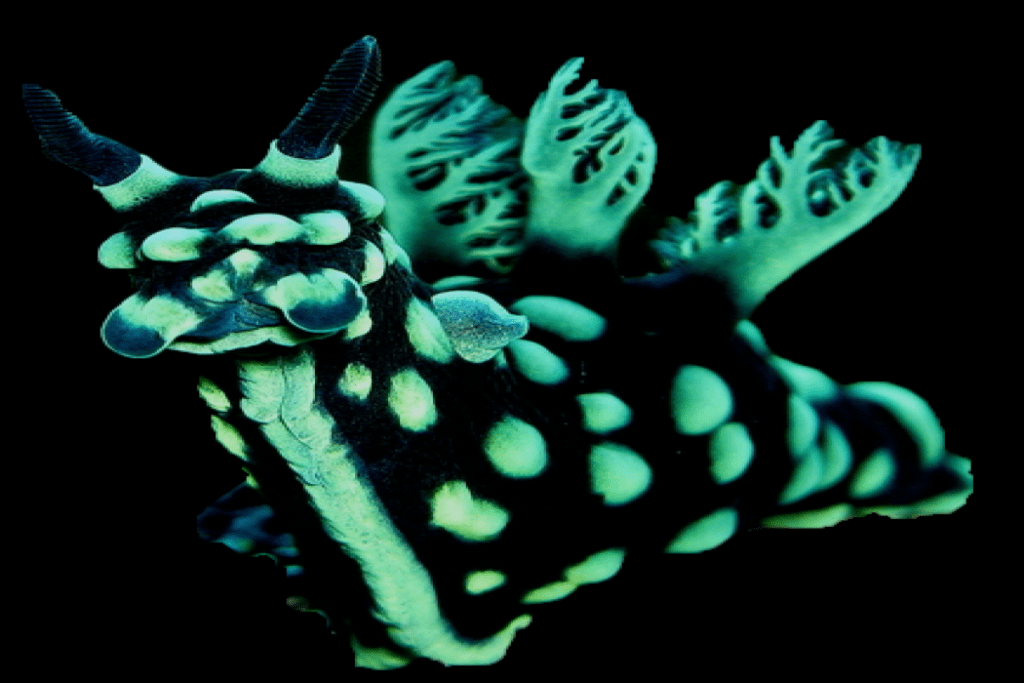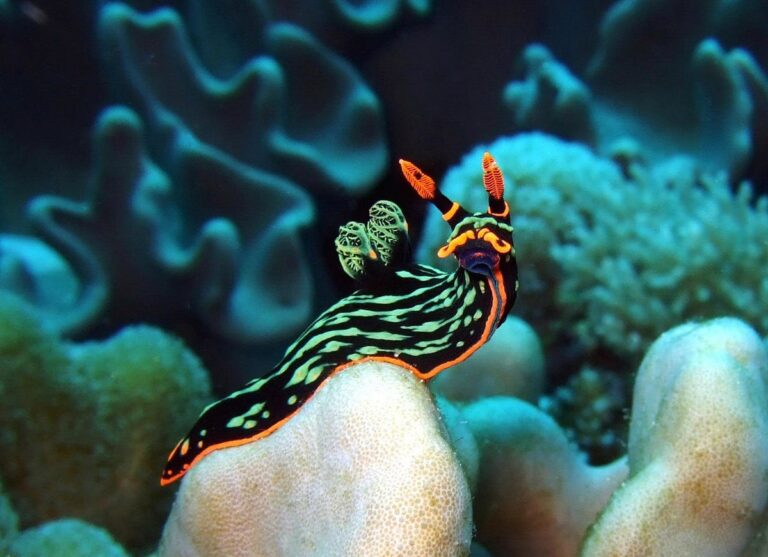Nudibranchs, often referred to as “sea slugs,” are among the most colorful and diverse creatures found in our oceans. These small, soft-bodied mollusks have captivated marine enthusiasts, divers, and scientists with their intricate patterns and dazzling hues. This article aims to delve into the vibrant world of the nudibranch, offering insights into their biology, behaviour, and their unique place in the marine ecosystem.
Classification and Physical Attributes of Nudibranchs
Nudibranchs belong to the Gastropoda class within the Mollusca phylum. While the term “sea slug” might imply a lack of diversity, there are actually over 3,000 known species of nudibranchs, each with its unique coloration and form.
Unlike their mollusk relatives, such as snails, nudibranchs lack an external shell. However, they make up for this absence with a stunning display of colours, which serve as warning signs to potential predators about their toxicity. Ranging in size from a few centimetres to over 12 inches, nudibranchs have two tentacle-like structures called rhinophores on their head, which help them sense their environment.
Diet and Defence Mechanisms of Nudibranchs

Nudibranchs are carnivorous, feeding mainly on sponges, coral polyps, and even other sea slugs. Their diet is particularly interesting because it directly influences their colour and defence mechanisms. Some nudibranch species can assimilate the toxic chemicals or stinging cells from their prey into their own tissues. This not only provides them with a unique form of defence but also can affect their coloration, making them a vivid display of “look, but don’t touch.”
Another fascinating aspect of the nudibranch’s defence mechanism is their ability to produce their own toxins. Predators quickly learn that these brightly coloured creatures are not a palatable meal, associating their bright patterns with a foul taste or harmful effects.
Reproduction and Lifecycle
Nudibranchs are hermaphroditic, meaning each individual possesses both male and female reproductive organs. This allows them to mate with any other member of their species they encounter, increasing the chances of reproduction. After mating, both nudibranchs can lay eggs, often depositing them in spiral patterns or gelatinous masses, depending on the species.
The eggs hatch into larvae, which are planktonic and drift in the ocean currents. This larval stage is crucial for dispersing the species across vast oceanic distances. As they mature, the larvae eventually settle onto the ocean floor and metamorphose into the colourful sea slugs we recognise.
Habitat and Distribution
Nudibranchs can be found in seas worldwide, from the shallow, tropical waters of the Indo-Pacific to the colder depths of the Arctic and Antarctic regions. While many species prefer warmer waters, where coral reefs provide an abundance of food sources, others have adapted to life in the deep sea or colder waters.
Divers often seek out nudibranchs in popular diving spots. The creatures’ vibrant colors make them a coveted find for underwater photography, and their slow-moving nature allows for prolonged observation.
Conservation and Importance in Marine Ecosystems
As with many marine species, nudibranchs face threats from climate change, habitat destruction, and pollution. Coral bleaching events, driven by rising ocean temperatures, can reduce the availability of food for many nudibranch species.
Nudibranchs play a vital role in marine ecosystems. Their feeding habits can help control populations of certain organisms, ensuring balance in their habitats. Moreover, their sensitivity to environmental changes makes them excellent indicators of ocean health.
Cultural and Historical Significance
Throughout history, marine creatures have always held a place of fascination in various cultures, and nudibranchs are no exception. Indigenous communities living near coastal areas often had tales and legends centred around these brightly coloured sea slugs. Some considered them as ocean spirits or as guardians of the undersea realm.
Moreover, the term ‘nudibranch’ itself provides insight into how these animals were historically perceived. Derived from the Latin words ‘nudus’ (naked) and ‘branchia’ (gills), the name references their exposed, feathery gills, which are another distinct feature of these captivating creatures.
Research and Medical Potential
The nudibranch’s ability to produce or store toxins presents significant potential for medical and pharmaceutical research. Some toxins, when studied and modified, may lead to the development of new painkillers, anti-inflammatory drugs, or even treatments for certain diseases. The unique compounds found in nudibranchs are a gold mine for bioprospecting, an area of research that seeks valuable chemical compounds in natural sources.
In recent years, the fluorescent proteins in certain nudibranch species have also gained attention. These proteins are studied for potential applications in biological imaging, allowing researchers to visually track cellular processes in real-time.
Observing Nudibranchs: A Guide for Enthusiasts
For those interested in observing these creatures firsthand, there are several key pointers to keep in mind:
- Be Gentle and Respectful: As delicate creatures, nudibranchs can be easily harmed by rough handling. Observing them without touching ensures their safety and that of their habitat.
- Look Closely: Due to their size and camouflaging abilities, nudibranchs can sometimes be overlooked. A keen eye and patience are essential.
- Document Your Findings: Take photographs or make notes of the nudibranchs you encounter. This can aid in species identification and provide valuable data for marine biologists studying distribution patterns.
Nudibranchs and the Future of our Oceans
The fate of the nudibranch is closely tied to the health of marine ecosystems. As our oceans face unprecedented threats from pollution, overfishing, and climate change, the well-being of creatures like the nudibranch serves as an indicator of the overall health of these ecosystems.
Promoting marine conservation is not just about saving charismatic megafauna like whales and dolphins; it’s also about preserving the myriad of smaller, less-known species that together form the complex web of marine life. The nudibranch’s survival is intricately linked to the health of coral reefs, the availability of its prey, and the cleanliness of its habitat.
Find out more from leaders in conservation here.

In Conclusion
Nudibranchs are more than just beautiful sea slugs; they represent the diversity, complexity, and fragility of marine ecosystems. As we continue to learn more about these enchanting creatures, we are reminded of the importance of conservation and the role each species plays in the broader marine tapestry. Whether as subjects of research, icons of marine biodiversity, or simply as wonders of the natural world, nudibranchs underscore the richness of life beneath the waves and the responsibility we bear to protect it.
UP NEXT
The Blue-Ringed Octopus: The Deadly Reef Dweller
The Life & Habits of The Atlantic Bluefin Tuna



